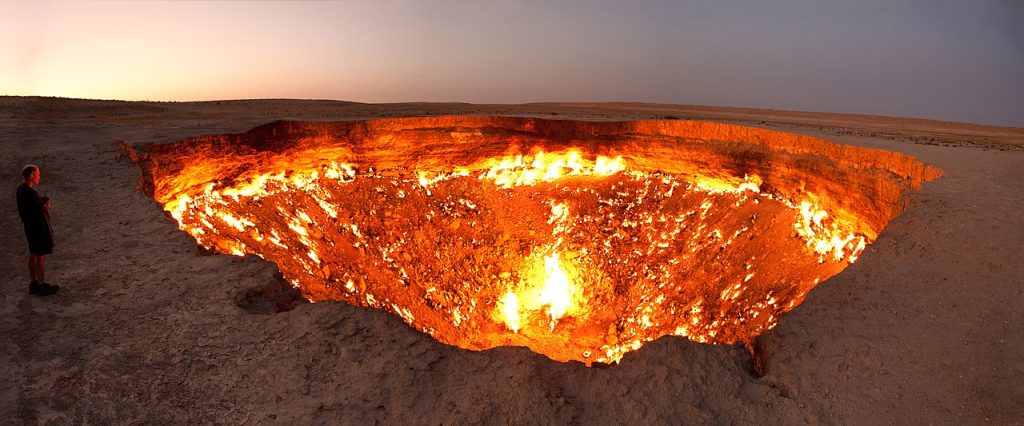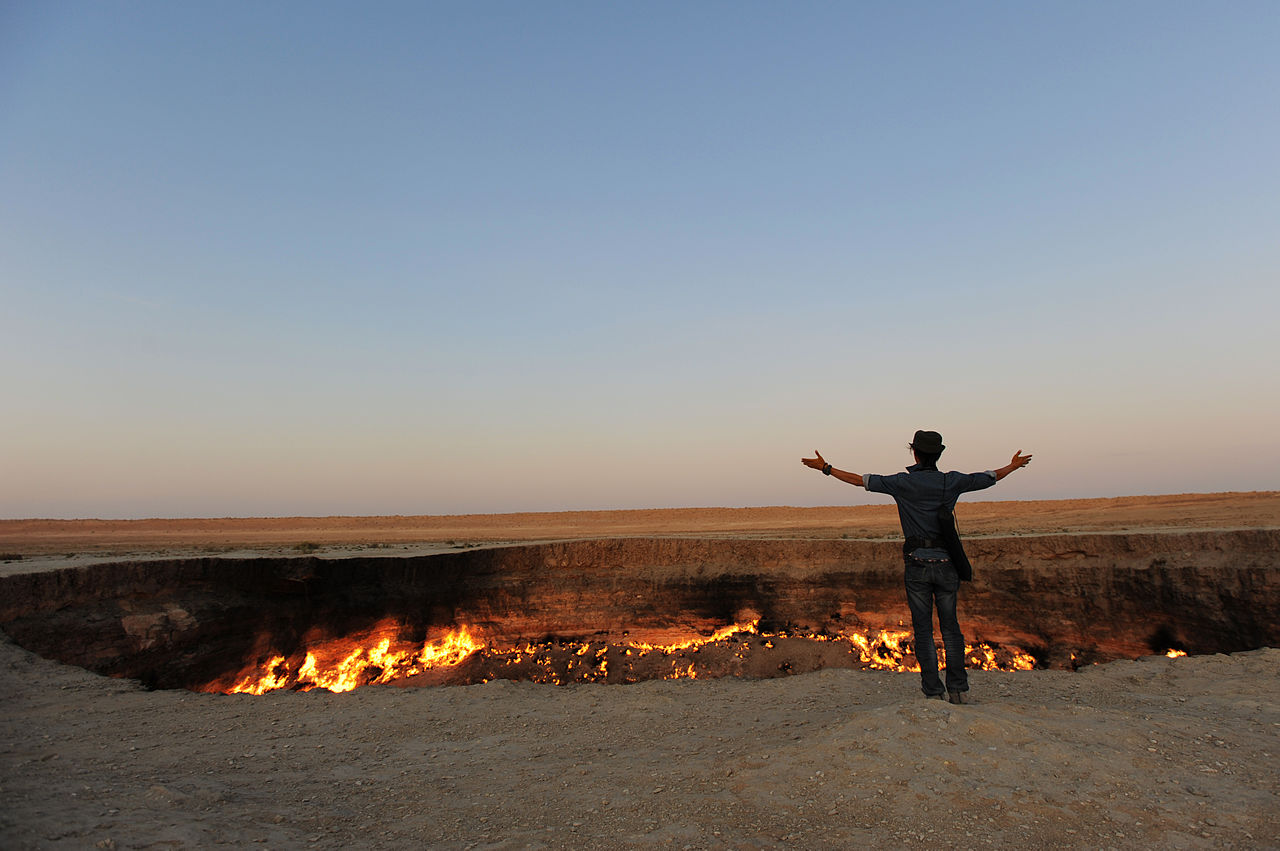 or over fifty years, a burning crater in the Karakum Desert of Turkmenistan has been a source of mystery and fascination, earning it the nickname “The Gates of Hell”. After a two-year effort by the local government and international organizations, the flames have finally been extinguished, inspiring hope for other environmental catastrophes and sparking greater public awareness on climate change. In this article we will explore the history of Darvaza Gas Crater, what caused it to erupt in such dramatic fashion and how its successful extinguishing can lead to further positive change.
or over fifty years, a burning crater in the Karakum Desert of Turkmenistan has been a source of mystery and fascination, earning it the nickname “The Gates of Hell”. After a two-year effort by the local government and international organizations, the flames have finally been extinguished, inspiring hope for other environmental catastrophes and sparking greater public awareness on climate change. In this article we will explore the history of Darvaza Gas Crater, what caused it to erupt in such dramatic fashion and how its successful extinguishing can lead to further positive change.
A Quick History of the Darvaza Gas Crater
Deep in the Karakum Desert of Turkmenistan is an unusual sight – a burning crater that has been nicknamed “The Gates of Hell” due to its eerie glow. This crater, known as the Darvaza Gas Crater, was created in 1971 when Soviet geologists set an underground gas pocket on fire during oil exploration. Since then, the crater has been burning continuously and is believed to be the only burning natural gas crater in the world.
For nearly 50 years, this phenomenon has captivated onlookers from near and far. It has become something of a tourist attraction, drawing in visitors from all over who want to witness its unique beauty. However, it was not until recently that any serious attempts were made to put out the flames and turn it into an eco-tourism spot.
In 2019, local government officials announced ambitious plans to extinguish The Gates of Hell and turn it into an eco-tourism site. This move was welcomed by environmentalists around the world who saw it as a sign of hope for other environmental catastrophes. The project involved drilling holes around the perimeter of the crater and pumping water down them to create a barrier between oxygen and fuel sources that were keeping it alight. After two years of hard work by local authorities and international organizations alike, their efforts finally paid off – on April 20th 2021 the flames were extinguished for good!
This success story provides renewed hope for other environmental catastrophes around the world and allows us to take greater action on climate change issues. The Darvaza Gas Crater serves as both a reminder of our past mistakes but also our potential for positive change if we are willing to put in hard work towards our goals.
What Happened at Darvaza?

Situated in the Karakum Desert of Turkmenistan, the Darvaza Gas Crater is one of the most extraordinary places on Earth. In 1971, a drilling rig inadvertently pierced an underground gas field, creating a 70-meter-wide hole and leading to what is now known as The Gates of Hell. To prevent further spread of methane gas, geologists set the crater ablaze – sparking a blaze that burned nonstop for over five decades before it was finally extinguished in April 2021.
This remarkable environmental disaster has also become something of a tourist destination due to its strange beauty and eerie glow, with visitors coming from all over the world to witness this unique phenomenon first hand. Yet its successful resolution serves as an encouraging reminder that even our mistakes can be corrected if enough effort is put into them – providing renewed hope for other ecological catastrophes and greater action on climate change.
The fact that it took 50 years for Darvaza Gas Crater’s flames to be extinguished gives us serious cause for reflection when considering how best to tackle today’s environmental issues. It clearly demonstrates the need for increased public awareness, political willingness and international cooperation if we are going to succeed in protecting our planet from human destruction so future generations can enjoy living on a healthier planet.
The Impact on the Local Environment
The Darvaza gas crater has had a profound effect on the local environment. The release of methane and other gases into the atmosphere created a toxic environment, depleting soil fertility levels and posing a health risk to humans living in the nearby areas. In addition, the unstable nature of the crater has caused sinkholes, landslides, and other movements of the earth. The intense heat emanating from it also forced many animals out of their natural habitats.

The environmental damage caused by this phenomenon is far-reaching and still not fully understood. For example, one study found that high concentrations of methane emitted from the crater led to an increase in air pollution levels in nearby towns. This has been linked to higher rates of asthma among children who live there, as well as increased risks for cardiovascular disease among adults.
Furthermore, researchers have observed changes in vegetation patterns near the crater that are likely due to its intense heat output. These areas now contain fewer plant species than before—a consequence that can potentially lead to greater extinction rates in some species over time and further disruption of already fragile ecosystems.
Finally, it’s worth noting that while this single event was able to be resolved through international aid efforts and local government initiatives, similar catastrophes could emerge at any moment—especially with global climate change occurring at such alarming rates today. It’s important that we pay attention to these events so they don’t get out of hand and cause permanent damage like this one did for over 50 years.
Government and International Efforts to Extinguish the Flames
For over fifty years, the Darvaza gas crater in Turkmenistan has been a source of environmental disaster and a reminder of the effects of climate change. In 2010, the Turkmenistan government began efforts to extinguish the flames in the crater, culminating in 2016 with the assembly of an international team of scientists and engineers. This team was able to reduce the size of the crater by injecting it with coolants and using specialized flame-retardant foam to help extinguish residual flames. Over two years later, these efforts have paid off as they were finally successful in quelling all remaining fires at the site.
The international effort that went into this project is remarkable – it involved experts from several countries cooperating together to develop a plan to put out a fire that had burned for over half a century. The success of this endeavor is evidence that global collaboration on environmental issues is possible and can be effective. It also serves as an example for other nations facing similar challenges; if their governments can come together and cooperate on solutions, great progress can be made towards protecting our planet from human destruction.
The success at Darvaza also demonstrates how local authorities are willing to invest resources into solving environmental problems even when there may not be any immediate or tangible benefits for them. By investing time and money into resolving this catastrophe, Turkmenistan has sent a strong message about its commitment to protecting its environment for future generations. It’s hoped that other nations will follow suit and embrace environmentally friendly policies in their own countries as well.
In addition to providing hope for future catastrophes, this victory sends an important message about public awareness regarding environmental issues: we cannot sit idly by while our planet suffers from human damage caused by climate change or other ecological disasters – we must take action now before it’s too late! With increased public engagement and political action, we can make real progress towards saving our planet from further destruction.
How the Successful Extinguishing of the Crater Can Lead to Further Positive Change
The successful containment of the Darvaza gas crater in Turkmenistan is an incredible milestone in environmental protection that could lead to meaningful progress for similar issues around the world. This event has encouraged greater investment in renewable energy sources, which will decrease reliance on fossil fuels and reduce greenhouse gases that are detrimental to our atmosphere. Moreover, it can inspire citizens to get involved with climate change initiatives at both local and international levels.
Local authorities should also take this opportunity to educate their communities on eco-friendly practices such as reducing carbon emissions or participating in clean-up efforts. Through public education campaigns, people will gain a better understanding of pressing ecological issues and create sustainable habits that can help preserve natural resources, reduce air pollution, and minimize waste generation. Governments have the power to incentivize businesses investing in green technology with tax breaks or grants – encouraging them to adopt more environmentally conscious production methods.
The Darvaza gas crater success story highlights how collaboration between different parties can bring about great successes when it comes to tackling environmental catastrophes and creating a more sustainable future for all species inhabiting our planet – including us! With increased public awareness and commitment from governments towards preserving the environment, we can ensure no other disaster like this ever occurs again – helping us protect our planet for generations to come!
Avid Writer with invaluable knowledge of Humanity!
Upcoming historian with over 30 million views online.
“You make your own life.”





